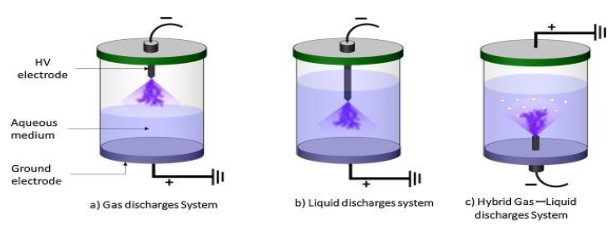DBD Plasma
Dielectric-barrier discharges (DBD), sometimes known as barrier discharges or quiet or inaudible discharges, have long been linked only to the production of ozone. In addition to the discharge space, dielectric-barrier discharges are distinguished by the existence of one or more insulating layers in the current route between metal electrodes.

In highly industrialized and heavily populated regions, environmental pollution became a very big problem and reached an unacceptable levels. It is harmful for mankind as well as the entire biodiversity. Air and fresh water is necessary requirements to sustain a biological life. Now we are looking the major aspects of water and air pollution and investigate them. Additionally, we evolve them and obtain clean drinking water and healthy air by using a variety of technologies.
1 -WATER POLLUTION
When the fresh water is mixture of unwanted or undesirable combination of pH, suspended impurities, heavy metals, oil and derivatives compounds, algae and bacteria, silts and sediments, radioactive substances, pathogens, oxygen-demanding wastes, nutrients, and pesticides, is called waste water or polluted water.
Why we need water cleaning technologies?
The liquid that enables life on Earth is water. Water is a necessity for all living things, including enormous blue whales and microscopic bacteria. Water is an essential resource for aquatic and human life. Because of the world’s population growth, there is an increasing demand for clean water, which has led scientists to create a variety of conventional wastewater treatment methods, including physical, chemical, and biological water treatment. Among them, the application of chemical procedures is common. Nevertheless; there are a number of drawbacks to all of these methods, including inorganic solid and unreacted chemical leftovers. In order to address these problems, scientists have concentrated on advanced oxidation processes (AOPs), such as non-thermal plasma (NTP) and photo-Fenton method.
Advantages ‘plasma treatment:
The majority of nations nowadays are aware of the seriousness of wastewater containing dyes, also referred to as organic pollution chemicals. A large number of researches have been conducted recently on the use of electrical discharge plasmas for wastewater treatment. Furthermore, because of their adaptable nature, plasma procedures can be combined with other cutting-edge oxidation techniques.
Because of its ease of use, economy, environmental friendliness, and effectiveness in eliminating harmful organic compounds found in wastewater and raw water, the use of plasmas in water treatment has attracted a lot of interest. Researchers in a range of application domains, such as environmental and wastewater remediation, nonmaterial processing, cancer cell treatment, sterilisation and disinfection, bacterial bio film prevention and eradication, analytical chemistry, etc., have shown a great deal of interest in plasma-liquid systems in recent years.
Specifically, methods for treating plasma have been tested: 1) for the breakdown of numerous toxic substances found in water, such as pesticides, herbicides, phenols, organic dyes, As3+, Cr6+, Fe3+, Cu2+, and Zn2+, virus and bacterial inactivation bio molecules, pharmaceuticals, and veterinary antibiotics. 2) For the purpose of improving the biodegradability of coking wastewater and potentially eliminating chemical and biological wastes in all three states—gas, liquid, and solid.

2- Air Pollution
Over the past fifty years, advancements in industrial processes for producing various goods have resulted in increased first matter consumption and, as a result, an acceleration of the tendency towards the formation of solid, liquid, and gaseous wastes. Air pollution became an urgent priority to address in the context of ominous global warming-related issues, especially by creating dependable, affordable, and sustainable methods for the management and treatment of polluted gas streams despite their chemically complex and heterogeneous contents.
Major aspects of air pollution and its effect:
In actuality, inorganic substances such nitrogen oxides (NOx), ammonia (NH3), hydrogen sulphide (H2S), sulphur (SO2), or volatile organic compounds (VOCs; aldehydes, ketones, mercaptans, aromatics, etc.) that are frequently discharged into the environment without adequate treatment may be present in contaminated air. Furthermore, even at low concentrations, these gases could seriously impair the health of the workers in closed agricultural houses as well as that of the animals.
Advantage of plasma in air treatment:
The benefit of employing a non-equilibrium discharge over incineration and thermal plasma treatment is that the majority of the discharge energy can be used to accelerate electrons and produce free radicals. The fundamental parameters of the microdischarges in dielectric-barrier discharges can be adjusted to generate enough free radicals for the desired destruction reaction and prevent concentrations where radical-radical annihilation or radical-radical reassociation reactions become significant. This can be accomplished at atmospheric pressure and gas temperatures that are almost room temperature—a criteria that is essential to for flue gas or off-gas treatment.
DBDs are taken into consideration in particular when pollutant concentrations are low; say between 10 and 1000 ppm. The primary cause is that it becomes unfeasible to raise the temperature of the entire carrier gas flow to incineration levels (or even just too 200–500°C, the temperatures at which catalytic destruction can begin) at diluted pollutant concentrations. When many contaminants need to be treated at the same time, DBDs might be more advantageous than traditional techniques. Further effects resulting from UV light or from dielectric grains placed are being studied. The main advantages of DBDs over pulsed positive corona and electron beam radiation are their significantly simpler supply systems and considerably simpler up scaling. On the other hand, the self-terminating micro discharge mechanism engaged in DBDs operates across a wide variety of input frequencies with various voltage or current forms. Consequently, the use of dielectric-barrier discharges in non-thermal plasma decontamination of air contaminants has emerged as a viable and quickly developing technology.

Future with plasma (DBD) cleaning:
There are many prospective of discharge plasma or non thermal plasma in water and air pollution cleaning in recent and in future. The recent research and develop technologies increase the efficiency, by the use of process like photo catalysis, biodegradation, catalytic effects of activated carbon fibres, adsorbents, catalysts, ultrasound, ozone and other oxidant increase the efficiency to 60% to 80%. Others are Advanced Materials, Nanotechnology Integration, Economic Viability, Space Applications, Smart Grid Integration, Customized Solutions, Machine Learning and Automation, Global Collaboration.
If we are to continue to meet consumer demand, a number of issues will need to be resolved in future research and development. Future applications of plasma discharge for air and water treatment will mostly rely on how effective and how energy-efficient it is in comparison to other cutting-edge oxidation processes and treatment techniques overall, but there are also other considerations that must be considered. The device’s potential for widespread implementation will depend on various factors such as sustainability, convenience of use, initial and operating expenses, and gas supply.
SUMMARY
The need to use electrical discharge plasma technology for air filtration and the cleanup of industrial and fresh water pollution has grown dramatically in recent years. The medium of discharge considerably affects both the reactive species production and the degradation. The discharge plasma type, the activation mechanism, the internal design, the reactor’s scale, and the chemical composition of the polluted solution all affect the plasma reactor’s efficiency. The yield produced by a discharge plasma process that is linked with another process is contingent upon the nature of the coupled process, the combination of the two processes in post-treatment or pre-treatment, and the number of passes.
Like all treatment methods, the discharge plasma has several benefits for cleaning air and water, but it also has certain disadvantages. At both laboratory and pilot settings, plasma technologies in conjunction with other procedures appear to be pragmatic, affordable, efficient, and innovative approaches for eliminating aqueous pollutants.












